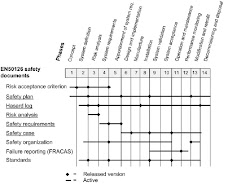Although it is not as easy to measure! - We do not have any handy measuring instruments to measure "risk" - like e.g. a Geiger counter, which can measure radioactivity.
We only have the Statistics to measure back in time and the Risk analysis to measure ahead, see the Figure below.

Interpretation
The figure above shows the close relationship between statistics and risk analysis.
This relationship is often forgotten: In many projects, a "Risk department" from e.g. the Supplier creates a large hazard log for a complex interlocking system, filled up with complex fault trees with many hard-to-understand branches.
Afterwards, an independent Assessor is asked to assess the Risk analysis, and the Assessor creates a huge hard-to-understand assessment report.
However, it should not be that complicated; when the close relationship between statistic and the risk analysis is kept in mind, the statistics can be a helpful tool to get a feeling of the quality of a hazard log.
Let's say we have the statistics from
- "Passengers traps in doors for a train fleet",
- "Trains parsing a red signal on a certain line" or
- "Accidents in level crossings pr. year"
etc.
Once we have such statistical numbers, it is often possible to find the corresponding branch in the hazard log.
If the numbers are close, it indicates that the hazard log somehow reflects and models the "real life". - Or maybe it needs adjustment.
It is also worth an effort to screen the hazards and pick out the "Top 5" hazards, which has the highest risk level.
In order to reduce the complexity, all branches in the hazards fault trees, which gives a low risk contribution, can be removed or compiled together.
Finally, the fault trees are simplified, easy to understand, can be controlled through statistics and evidently models the "real life".
Next chapter >> 1.4 The Safety Management Circle
Focus on the source (/EN 50126:1999/)
See "Quick Guide to Safety Management"




Ingen kommentarer:
Send en kommentar